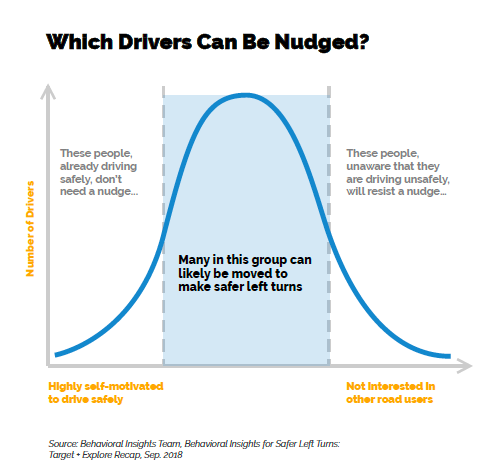Forty percent of the traffic deaths in San Francisco in 2019 were caused when drivers made left turns and didn’t see someone in the crosswalk they were heading into until it was too late.
This daunting bit of data caused the San Francisco Municipal Transportation Agency (SFMTA), under its Vision Zero commitment, to figure out how to encourage drivers to make safer left turns. Design changes were tested at seven intersections, and at the same time the agency undertook an educational campaign to make people aware of the problem.
The results, published in a report that was released today, show a 17 percent reduction in the average speeds of cars turning left at the test intersections, and a 71 percent reduction in the likelihood of a car turning left while going over 15 mph.
Crash data are not part of the report yet.
Data also show that the citywide decrease in pedestrian and bicycle traffic during the pandemic may have been slightly less at these intersections, perhaps because people felt safer using them on foot and on bikes. It's early days yet on these numbers, but they may point to another positive outcome of these safety interventions.
The full report, available here [PDF], details how the agency went about designing and implementing the study.
"Drivers need to judge many factors simultaneously when making a left turn," notes the report. "Given the complex decisions that have to be quickly made in a stressful environment, we can’t assume drivers will always make rational decisions when making a left turn." Researchers discovered that the most dangerous left-turn behaviors were speeding - some drivers turned without slowing down much at all - and cutting corners, in which they take up more of the crosswalk space and have a harder time seeing people crossing.
So in the fall of 2020, they installed various design interventions at seven intersections on the city's high-injury network, choosing different types of streets based on width, typical speed, and one- or two-way streets. Interventions included waist-high posts to mark centerlines more clearly, encouraging drivers to slow and make sharper turns; brightly colored rubber speed bumps extending the centerline into the intersection, and marking off "cuttable" corners at one-way to -one-way streets with rubber bumpers and painted wedges to encourage slow turns.
"Enhanced centerlines" were put in at Broadway and Montgomery, Lincoln and 17th Avenue, and Lincoln and 18th Avenue. "Slow turn wedges" with rubber speed bumps were installed at Gough and Sacramento, Ellis and Leavenworth, Leavenworth and Sutter, and 10th Street and Folsom.

In early 2021 the agency launched an educational campaign citywide, in various languages, through local organizations. "The intent was not to just tell people what to do—slow down—or make them feel guilty; no one wants to believe that their behavior is unsafe, so drivers tend to reject those messages," notes the report.
"Instead, the campaign offered [the statistic that forty percent of traffic deaths] are caused by drivers making left turns. This fact makes drivers pause and realize that making a left turn might not be as simple as they thought. They are then more receptive to adopting the campaign’s three safer left turn behaviors:
- Take it slow (5 mph is safest)
- Make it square (90-degree angles are best)
- Stay aware (look out for cars, cyclists, and people)."
The report highlights a couple of key takeaways. First, that "well-funded and evidenced-based education campaigns are an important and effective tool in raising public awareness, encouraging safer driving behaviors, influencing policy discussions, and building community support." They were able to reach a lot of people, use a variety of campaign strategies, and conduct strong community outreach because they had a large grant.
Second, the Left Turn Traffic Calming project ought to be copied. "Results are most promising," notes the report, "where existing left-turn speeds are high and/or a significant portion of left-turns are greater than 15 mph." But that shouldn't stop planners and engineers from applying some of these design elements as a standard - nor from building them in from the get-go when redesigning or repaving many intersections.






